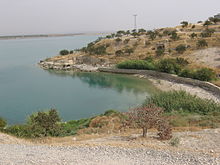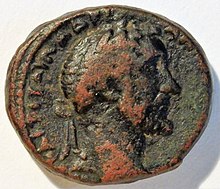Zeugma (city)
Coordinates: 37 ° 3 ′ 31 ″ N , 37 ° 51 ′ 57 ″ E
Zeugma ( Greek: Ζεύγμα [ bridge city ]) was a city located on the western bank of the Euphrates in ancient times . On the other bank was Seleukia Apamea ( Seleukeia on the Euphrates ). Because of its pontoon bridge , the twin cities were an important stage on the Silk Road . Zeugma is located in what is now eastern Turkey near Belkis on Belkis Dağı near Birecik in the Nizip district of the Gaziantep province . In October 2000, the ancient city was largely flooded by the Turkish Birecik barrage as part of the Southeast Anatolia project . A significant part of the zeugma's art treasures, especially mosaics, could previously be saved through emergency excavations and is now exhibited in Gaziantep .
history
Zeugma was founded by Seleukos I Nicator at the point where he had the first bridge built over the Euphrates in the early 3rd century BC. Founded as a Greek polis . The city developed already in Hellenism into a major commercial and administrative center and fell after the end of the Seleucid Empire in Rome . In its heyday, around 70,000 people lived in the city, which is protected by a legion . It was destroyed by the Sassanids in 252 or 256 AD , but rebuilt; but the time of the highest bloom was over. Later the city was probably devastated by an earthquake , part of the mountainside slid onto the residential area in the city center and buried it under itself. The houses below are particularly well preserved. A man-high sewer pipe made of calibrated stone blocks leading to the river, which was still in perfect condition when it was discovered, ensured rapid drainage for daily needs and in the event of heavy rainfall. In late antiquity , Zeugma was a diocese , the place seems to have been abandoned in the 7th century in the face of Persian and Arab raids. Arabs lived here for a while in the Middle Ages, and the Turkish village of Belkis arose near the ruins in the 17th century.
research

Since the 19th century, excavations in the vicinity of Zeugma have uncovered necropolises and Roman mosaic floors. a. can be seen in the museums of Berlin and Saint Petersburg . From 1980 it was known that the GAP authority was planning a dam near Birecik. When Guillermo Algaze of the University of Chicago made a field survey in the region in 1989 , learned of the dam plans and made them public, no foreign institution or university showed any interest in Zeugma. The director of the museum in Gaziantep, Rifat Ergeç and his assistant Mehmet Önal, alerted the international archaeologist again in 1994 and at the same time announced the start of sporadic rescue excavations, which also received some support from the Turkish Ministry of Culture. Due to a lack of money, the archaeological institutes and the Turkish Ministry of Culture were unable to finance a systematic excavation. In 1995 the French Foreign Ministry stepped in and supported the French archaeologist Catherine Abadie-Reynal and her colleagues in the Turkish rescue excavations until 1999.
In 2000 the ruins of Zeugma were flooded by the Birecik dam . On May 7, 2000, six months before the flood, American patron David W. Packard read about Zeugma in the New York Times and spontaneously decided to support an emergency excavation . He immediately commissioned an English company, the Oxford Archaeological Unit (OAU), led by Robert Earley, Italian mosaic specialists and a French team to rescue the most precious artifacts. Sixty archaeologists and 200 workers worked at full speed using three new excavators thanks to a budget of five million dollars. During the emergency excavation from June to October 2000 alone, they found 45 mosaics, 22 of which were almost intact.
Even before the scheduled flooding, which was delayed by President Sezer for 10 days, the now submerged Zeugma was also called the “second Pompeii ”. The mosaics were initially exhibited in the Archaeological Museum of Gaziantep , and in May 2011 the specially built Zeugma Mosaic Museum was opened.
literature
- Jörg Wagner: Seleukia on the Euphrates, Zeugma. Studies of historical topography and history. Reichert, Wiesbaden 1976, ( Supplements to the Tübinger Atlas des Vorderen Orient Series B 10, ZDB -ID 185712-5 ), (At the same time: Münster (Westf.), Univ., Diss., 1973).
- David Kennedy: The twin towns of Zeugma on the Euphrates. Rescue work and historical studies. Journal of Roman Archeology, Portsmouth RI 1998, ISBN 1-887829-27-X , ( Journal of Roman Archeology Supplementary Series 27).
- Nezih Başgelen, Rifat Ergeç: Belkis - Zeugma, Halfeti, Rumkale - a last look at history. Archeology and Art Publications, Istanbul 2000, ISBN 975-6899-70-0 .
- Robert Early: Zeugma. Interim reports. Rescue excavations (Packard Humanities Institute), inscription of Antiochus I, bronze statue of Mars, house and mosaic of the Synaristôsai, and recent work on the Roman army at Zeugma. (= Journal of Roman archeology Supplementary series 51). Journal of Roman Archeology, Portsmouth RI 2003, ISBN 1-887829-51-2 .
- Catherine Abadie-Reynal: Séleucie-Zeugma et Apamée sur l'Euphrate. Etude d'un cas de villes jumelles dans l'Antiquité . In: Histoire urbaine 3, 2001, ZDB -ID 2021751-1 , pp. 7-24, doi : 10.3917 / rhu.003.0007
- Catherine Abadie-Reynal, Alix Barbet (Ed.): Zeugma
- Vol. 1: Fouilles de l'habitat 1: La mosaïque de Pasiphae . De Boccard, Paris 2012.
- Vol. 2: Peintures murales romaines. De Boccard, Paris 2005.
- Vol. 3: Fouilles de l'habitat. 2: La maison des Synaristôsai. Nouvelles inscriptions. De Boccard, Paris 2012.
- Mustafa Büyükkolanci: The villas on terrace A in Zeugma . In: Forum Archaeologiae 16 / IX / 2000 online
Documentaries
- Zeugma, an ancient city is disappearing. Documentation, France, 2000, 52 min, Director:. Thierry Ragobert, production: arte , Summary
- Zeugma. Documentation, USA, 2003, directors: Micah Garen and Marie-Hélène Carleton, production: Four Corners Media, table of contents ( Memento from September 28, 2007 in the Internet Archive )
- The Conservation of the Roman town of Zeugma 2000-2004. Centro di Conservazione Archeologica (CCA) Roma youtube
Web links
- Site of the ancient city (Engl.)
- www.zeugma2000.com ( Memento of February 8, 2004 in the Internet Archive ) - The Packard Humanities Institute (financier of the emergency excavation)
- Zeugma Bibliography , University of Western Australia
items
- "Dam in Turkey May Soon Flood A '2nd Pompeii'" , New York Times , May 7, 2000 and other articles
- “Barrage sur le moyen Euphrates. Que reste-t-il des villes jumelles de Zeugma et d'Apamée? " CRNS-info , summer 2000, on Catherine Abadie-Reynal's excavation campaigns (PDF file, 4 pages) (French; 421 kB)
- “Sacrificed to the Stream” , Die Zeit , October 20, 2000, no. 42
- "Race against time. Ancient treasures come to light before disappearing under water " ( Memento from October 19, 2007 in the Internet Archive ), Rolex Award 2004 for Catherine Abadie-Reynal (PDF file, 5 pages; 2.0 MB), (html file) ( Memento from April 9, 2008 in the Internet Archive )
- photos
- Images of Zeugma's mosaics
- Photo gallery of 32 rescued mosaics, statuettes, etc.
- Mosaics in the Gaziantep Archaeological Museum
swell
- ↑ Helmut Stalder: "Zeugma has sunk in the water grave". Tages-Anzeiger , November 14, 2000





